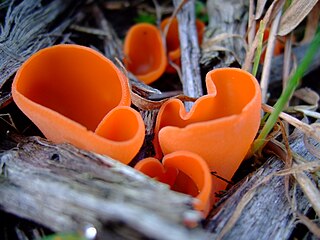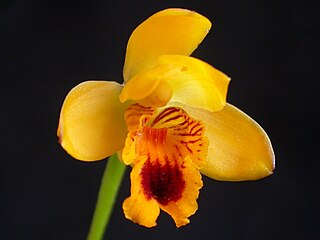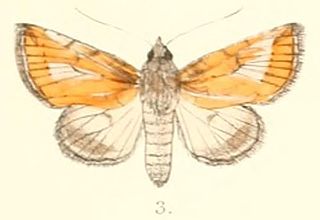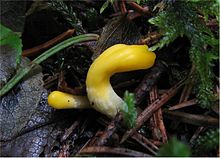
Salix alba, the white willow, is a species of willow native to Europe and western and central Asia. The name derives from the white tone to the undersides of the leaves.

Pezizomycotina make up most of the Ascomycota fungi and include most lichenized fungi too. Pezizomycotina contains the filamentous ascomycetes and is a subdivision of the Ascomycota. It is more or less synonymous with the older taxon Euascomycota. These fungi reproduce by fission rather than budding and this subdivision includes almost all the ascus fungi that have fruiting bodies visible to the naked eye.

The Taphrinomycotina are one of three subdivisions constituting the Ascomycota and is more or less synonymous with the slightly older invalid name Archiascomycetes. Recent molecular studies suggest that the group is monophyletic and basal to the rest of the Ascomycota.

Neolecta is a genus of ascomycetous fungi. The species share the English designation "Earth tongues" along with some better-known fungi with a similar general form, but in fact they are only distantly related.
Anstisia vitellina, commonly known as the orange-bellied frog, is a species of frog in the family Myobatrachidae. It is endemic to a 20 hectare area near Margaret River in Southwest Australia. It is vulnerable to extinction due to fire and the destruction of habitat caused by feral pigs.

The vitelline warbler is a songbird species in the New World warbler family (Parulidae). It is found in the Cayman Islands and on the Swan Islands in Honduras.
Utricularia vitellina is a small or very small, probably perennial carnivorous plant that belongs to the genus Utricularia. It is endemic to Peninsular Malaysia and is only known from two mountain peaks that are over 100 km (62.1 mi) apart. U. vitellina grows as a terrestrial plant in peaty stream banks among bryophytes at altitudes from 1,500 m (4,921 ft) to 2,100 m (6,890 ft). It was originally described by Henry Nicholas Ridley in 1923. It is distinct from the rest of the species in section Oligocista by not having a basal swelling of the lower corolla lip.

Mythimna vitellina, the delicate, is a moth of the family Noctuidae. The species was first described by Jacob Hübner in 1808. It is mainly distributed throughout southern Europe and the southern part of eastern Europe. It is also found far less commonly further north in Europe. Also in North Africa, the Near East and Middle East, Central Asia and western China.

Erato is a genus of small sea snails, marine gastropod molluscs in the family Eratoidae, the trivias and allies.

Bifrenaria vitellina is a species of orchid found in Brazil.

Rimbachia is a genus of fungi in the family Tricholomataceae. The genus contains about ten species with a widespread distribution in tropical regions.

Salix × sepulcralis 'Chrysocoma', or Weeping Golden Willow, is the most popular and widely grown weeping tree in the warm temperate regions of the world. It is an artificial hybrid between S. alba 'Vitellina' and S. babylonica. The first parent provides the frost hardiness and the golden shoots and the second parent the strong weeping habit.
This cross was originally made at the Späth Nursery and was first mentioned in their 1888 nursery catalogue as S. vitellina pendula nova.
Being a cultivar from the Chrysocoma Group, which includes all crosses between S. alba and S. babylonica, it is much hardier and more long-lived than the Babylon Willow. This particular cultivar is easily distinguished from the other Golden Weeping Willow by its androgynous catkins.

Dendrophthoe is a genus of hemiparasitic shrubs found in Asia and Australia known as mistletoes. The genus was described by German naturalist Carl Friedrich Philipp von Martius in 1830. Species in this genus have a variety of reported uses in the medical traditions of the region, most notably in Nepal.

Dendrophthoe vitellina, commonly known as long-flowered- or apostle mistletoe, is a hemiparasitic plant of the mistletoe family Loranthaceae. The genus Dendrophthoe comprises about 31 species spread across tropical Africa, Asia, and Australia. Despite being collected by Joseph Banks and Daniel Solander in 1788, and depicted in Banks' Florilegium, it was not until 1860 that it was described by Ferdinand von Mueller as Loranthus vitellinus after being collected near Ipswich, and renamed by Philippe Édouard Léon Van Tieghem in 1895.
Elachista vitellina is a moth of the family Elachistidae. It is found all over Australia.
Scopula vitellina is a moth of the family Geometridae. It is found in Cameroon.

Risoba vitellina is a species of moth of the family Nolidae first described by Frederic Moore in 1882. It is found in India.

Candelariella vitellina is a common and widespread green-yellow to orange-yellow crustose areolate lichen that grows on rock, wood, and bark, all over the world. It grows on non-calcareous rock, wood, and bark.
Artaxa vitellina is a moth of the family Erebidae first described by Vincenz Kollar in 1848. It is found in India and Sri Lanka.














